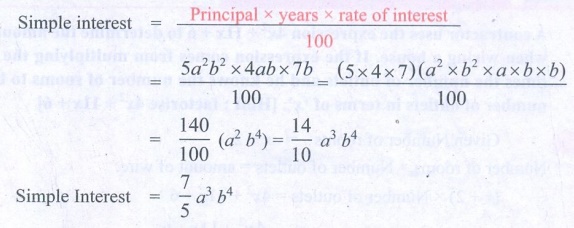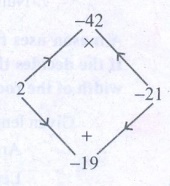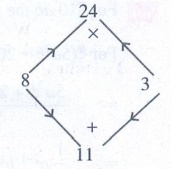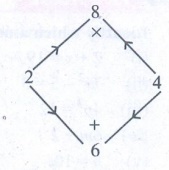Questions with Answers, Solution | Algebra | Chapter 3 | 8th Maths - Exercise 3.5 | 8th Maths : Chapter 3 : Algebra
Chapter: 8th Maths : Chapter 3 : Algebra
Exercise 3.5
Exercise
3.5
Miscellaneous
Practice Problems
1. Subtract: −2(xy)2 ( y 3 + 7x2 y + 5)
from 5y 2 (x2 y 3 − 2x4 y + 10x2 )
Solution:
5y2 (x2 y3
− 2x4y + 10x2) − [(−2) (xy)2
(y3 + 7x2y + 5)]
= [5y2 (x2 y3)
− 5y2 (2x4 y) + 5y2
(10x2)] − [(−2) x2y2 (y3
+ 7x2 y + 5)]
= (5y5x2 − 10 x4y3
+ 50 x2y2) − [(−2x2y2)
(y3) + (−2x2y2) (7x2y)
+ (−2x2y2) (5)]
= 5x2y5 − 10x4y3
+ 50x2y2 − [−2x2 y5
− 14x4y3 − 10x2y2]
= 5x2y5 − 10x4y3
+ 50x2y2 + 2x2 y5
+ 14x4y3 + 10x2y2
= (5 + 2) x2y5 + (−10 + 14) x4y3
+ (+50 + 10)x2y2
= 7x2y5 + 4x4y3
+ 60x2y2
2. Multiply ( 4x2 + 9) and
( 3x − 2)
Solution:
(4x2 + 9) (3x − 2) = 4x2
(3x − 2) + 9 (3x − 2)
= (4x2) (3x) − (4x2)
(2) + 9 (3x) − 9(2) = (4 × 3 × x × x2) − (4 × 2
× x2) + (9 × 3 × x) − 18
= 12x3 − 8x2 + 27x − 18
(4x3 + 9) (3x− 2) = 12x3 − 8x2
+ 27x − 18
3. Find the simple interest on Rs. 5a 2b2 for 4ab years
at 7b% per annum.
Solution:

Simple interest = [ Principal
× years × rate of interest ] / 100
= [ 5a2b2 × 4ab × 7b
] / 100 = [ (5 × 4 × 7) (a2 × b2 × a ×
b × b) ] / 100
= (140/100) (a3 b4) = (14/10)
a3 b4
Simple Interest = (7/5) a3 b4
4. The cost of a note book is Rs. 10ab. If Babu has Rs. ( 5a 2b + 20ab 2 + 40ab) . Then how many note books can he buy?
Solution:
For ₹10 ab the number of note books can buy = 1.
For ₹ (5a2b + 20ab2 +
40 ab) the number of note books can buy = Total amount
/ cost of 1 note book

= [ 5a2b + 20ab2 + 40ab
] / 10 ab = [ 5a2b / 10ab ] + [ 20ab2
/ 10ab ] + [ 40ab / 10ab ]
= 1/2 [ a2−1
b1−1 ] + [ 2 a1−1 b2−1 ] +
[ 4 a1−1 b1−1 ] = (1/2)a1
b0 + 2 a0 b1 + 4 a0
b0
Number of note books he can buy = (½)a + 2b + 4
5. Factorise : ( 7y2 − 19y − 6)
Solution:
7y2 − 19y – 6 is of the form ax2 + bx + c where a = 7; b = −19; c = − 6
Product = −42 : Sum = −19
1 × −42 = −42 : 1 + (−42) = −41
2 × −21 = −42 : 2 + (−21) = −19
The product a × c = 7x − 6 = − 42
sum b = −19

The middle term − 19y can be written as − 21y + 2y
7y2 − 19y − 6 = 7y2 −
21y + 2y − 6
= 7y (y − 3) + 2 (y − 3) = (y − 3) (7y
+ 2)
7y2 − 19y − 6 = (y − 3) (7y + 2)
Challenging
problems
6. A contractor uses the expression 4x2 + 11x + 6 to determine the amount of wire to
order when wiring a house. If the expression comes from multiplying the number of
rooms times the number of outlets and he knows the number of rooms to be ( x + 2), find the number of outlets in terms
of ‘x’. [Hint : factorise 4x 2 + 11x + 6 ]
Solution:
Given Number of rooms = x + 2
Number of rooms × Number of outlets = amount of wire.
(x + 2) × Number of outlets = 4x2 + 11x
+ 6
Number of outlets = [ 4x2 + 11x + 6 ] /
[ x + 2] ...(1)
Now factorising 4x2 + 11x + 6 which is
of the form ax2 + bx + c with a = 4 b
= 11 c = 6.
The product a × c = 4 × 6 = 24
sum b = 11
Product = 24 : Sum = 11
1 × 24 = 24 : 1 + 24 =
25
2 × 12 = 24 : 2 + 12 = 14
3 × 8 = 24 : 3 + 8 = 11

The middle term 11x can be written as 8x + 3x
∴ 4x2 + 11x + 6 = 4x2 +
8x + 3x + 6
= 4x (x + 2) + 3 (x + 2)
4x2 + 11x + 6 = (x + 2) (4x
+ 3)
Now from (1) the number of outlets

[ 4x2 +
11x + 6 ] / [ x + 2] = [ (x + 2) (4x + 3)] / (x
+ 2) = 4x + 3
∴ Number of outlets =
4x + 3
7. A mason uses the expression x2 + 6x + 8 to represent the area of the floor
of a room. If the decides that the length of the room will be represented by ( x + 4) , what will the width of the room be
in terms of x ?
Solution:
Given length of the room = x + 4
Area of the room = x2 + 6x + 8 = x2
+ 6x + 8
Length × breadth = x2 + 6x + 8
Breadth = [ x2 + 6x + 8 ] / [ x
+ 4 ] ……(1)
Factorizing x2 + 6x + 8, it is in the
form of ax2 + bx + c
Where a = 1 ; b = 6 ; c = 8;
The product a × c = 1 × 8 = 8
Sum = 6
Product = 8 : Sum = 6
1 × 8 = 8 : 1 + 8 = 9
2 × 4 = 8 : 2 + 4 = 6

The middle term 6x can be written as 2x + 4x
∴ x2 + 6x + 8 = x2 + 2x + 4x
+ 8
= x (x + 2) + 4 (x + 2)
x2 + 6x + 8 = (x + 2) (x + 4)
Now from (1)
breadth = [ x2 + 6x + 8 ] / (x +
4) = [ (x + 2) (x + 4) ] / (x + 4) = (x + 2)
∴ Width of the room =
x + 2
8. Find the missing term: y2 + (…) x + 56 = (y+7)(y+..)
Solution:
We have (x + a) (x + b) = x2
+ (a + b)x + ab
56 = 7 × 8
∴ y2 + (7 + 8)x + 56 = (y
+ 7) (y + 8)
9. Factorise : 16 p4 −1
Solution:
16p4 − 1 = 24 p4
− 1 = (22)2 (p2)2 − 12
= (22p2)2 − 12
Comparing with a2 − b2 = (a
+ b) (a − b) where a = 22 p2 and
b = 1
∴ (22p2)2
− 12 = (22p2 + 1) (22p2
− 1)
= (4p2 + 1) (4p2 − 1)
∴ 16p4 − l = (4p2 + 1) (4p2
− 1) = (4p2 + 1) (22p2 − 12)
= (4p2 + 1) [(2p)2 − 12]
= (4p2 + 1) (2p + l) (2p − 1)
[ ∵ using a2 − b2
= (a + b) (a − b)]
∴ 16p4 − 1 = (4p2 + 1) (2p
+ l) (2p − 1)
10. Factorise : 3x3 – 45x2y + 225xy2 – 375y3
= 3x3 − 45x2y + 225xy2
− 375y3
= 3(x3 − 15x2y + 75xy2
− 125y3)
= 3(x3 − 3x2(5y) + 3x(5y)2
− (5y)3)
= 3(x − 5y)3
Exercise 3.5
Miscellaneous Practice
Problems
1. 7x2y5 + 4 x4y3 + 60x2 y2
2.12 x3 − 8x2 + 27x −18
3. S.I = 7/5 a3b4
4. 1/2 a + 2b
+ 4
5. ( y − 3)(7y + 2)
Challenging Problems
6. 4x + 3
7. x + 2
8. ( y + 7)( y + 8)
9. (4 p2 + 1)( 2p +1)(2p −1)
10. 3( x − 5y)3